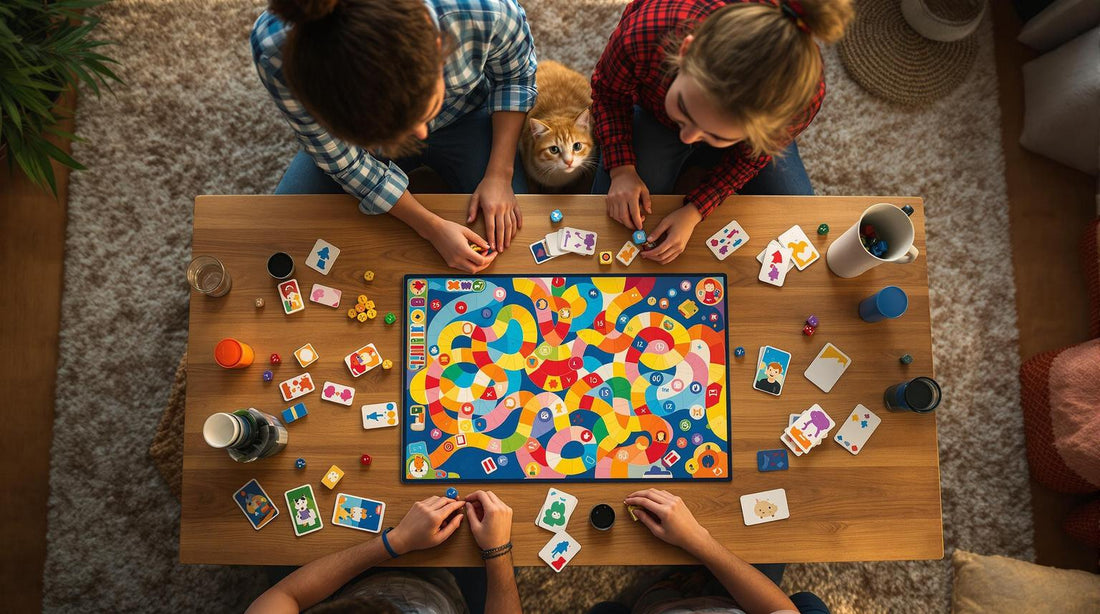Discover the Best Board Games for Every Player

How To Teach Board Games To Young Kids
Board games can help kids develop critical thinking, problem-solving, patience, and teamwork - all while having fun with family. Here’s how to get started:
- Choose age-appropriate games: For ages 3–4, pick simple, short games with large pieces. For ages 5–7, introduce basic strategy and counting games with slightly longer playtimes.
- Simplify the rules: Break down complex rules into small steps or turn them into stories to make learning fun and easy.
- Start with team games: Cooperative games like Just One or MicroMacro: Crime City help kids learn teamwork and problem-solving.
- Focus on fun: Celebrate small wins, encourage good sportsmanship, and keep the mood positive.
Family game nights create lasting memories while teaching life skills. Explore games like ICECOOL and Carcassonne for engaging and beginner-friendly options.
How to Introduce Your Children to Board Games
Picking Games for Young Children
Look for games that inspire creativity and help develop important skills. The key is to choose options that align with your child’s developmental stage.
Match Games to Age Groups
Here’s how to pick games based on your child’s age and abilities:
-
Ages 3–4:
- Large, easy-to-handle pieces
- Simple, one-step rules
- Focus on matching or color recognition
- Short playtimes (10–15 minutes)
-
Ages 5–7:
- Games with sequential play
- Introduce basic strategy
- Incorporate counting or simple math
- Slightly longer playtimes (20–30 minutes)
These tips can help you narrow down your options and find games that are both fun and educational.
Best Starter Games
Some games are perfect for young beginners and families. ICECOOL is a great choice, featuring twistable figures and easy-to-follow rules. It’s highly rated, with a score of 4.81/5.0 from 37 reviews.
Another excellent option is Carcassonne, which combines simple gameplay with engaging visuals. It’s rated 4.9/5.0 based on 39 reviews.
Here’s what makes these games stand out:
- Clear, easy-to-understand instructions
- Rules that can be simplified if needed
- Fun, engaging themes
- Quick and easy setup
- Durable components built to last
These games are great for easing kids into structured play while creating opportunities for family bonding.
For more ideas, check out Brain-Games.lv/en/.
Teaching Methods That Work
Teaching board games can be a fun and interactive way to engage kids while helping them understand the rules. By focusing on enjoyable and clear methods, you can make the learning process smoother and more effective.
Breaking Rules Into Manageable Steps
Simplify complex rules by dividing them into smaller, easy-to-follow steps. Here’s how:
- Start with a single, simple action or move.
- Introduce additional rules gradually, only after the previous ones are understood.
- Use language that’s easy for kids to grasp.
- Show how each rule works through demonstrations.
Turning Rules Into Stories
Transform the rules into an imaginative story that captures kids’ attention. For instance, describe the game as a quest to build a magical kingdom:
- Tiles become enchanted puzzle pieces.
- Game tokens represent characters like knights, farmers, or wise guides.
- Completing game objectives turns into heroic tasks for the kingdom.
Demonstrate and Practice
Start with a practice round to show how the game works. Guide them step-by-step without taking over, and use positive feedback to reinforce understanding. Here’s a suggested approach:
| Phase | Duration | Activity |
|---|---|---|
| Watch | 5–10 min | Show basic gameplay in action. |
| Try | 10–15 min | Practice gameplay with guidance. |
| Play | 15–20 min | Let them play independently with support. |
This structured sequence helps kids learn by seeing, trying, and doing, making the process both educational and enjoyable.
sbb-itb-1ed942f
Making Games Kid-Friendly
Once kids understand the basics, adjust the game setup to make it more enjoyable for them. You can tweak the rules and components of board games to match their skill levels and keep the experience fun.
Simplify Rules and Shorten Playtime
Simpler rules make it easier for kids to follow along and stay interested. You can adjust by focusing on straightforward victory conditions, shortening game rounds, or breaking up longer sessions into smaller chunks. These changes help keep their attention while maintaining the essence of the game.
Adjust Game Pieces for Little Hands
Using game pieces that are easier for kids to handle can make a big difference. Opt for larger tokens, dice, or cards that are more manageable for small hands. These small adjustments reduce frustration and help kids feel more confident while playing.
Keep Games Fun and Engaging
Making games enjoyable and positive is key to keeping kids interested. These tips build on earlier techniques like teaching methods and game tweaks.
Play for Fun
Focus on having a good time rather than just winning. Celebrate small achievements and treat mistakes as opportunities to learn. Highlight exciting moves or surprising outcomes to create a positive gaming atmosphere.
Reward Positive Behavior
Acknowledge kids for actions like:
- Practicing patience and good sportsmanship
- Helping others understand the rules
- Making thoughtful choices during the game
Recognizing these behaviors encourages a more enjoyable and rewarding gaming experience.
Start with Team Games
Cooperative games are a great way to introduce kids to gaming. They teach the basics while fostering family connections. Games like Just One and MicroMacro: Crime City emphasize teamwork and collaboration. During play, ask questions such as, "What should we do next?" or "How can we solve this together?" This approach not only makes the game more engaging but also helps kids build problem-solving skills while enjoying the social side of gaming.
Games Build Life Skills
Playing games isn't just about having fun - it’s an opportunity to teach valuable life skills. Board games encourage strategic thinking, decision-making, clear communication, and teamwork, all while keeping players engaged.
Quick Tips for Success
Here are some ways to make the most of game time:
- Choose age-appropriate games: Pick games that align with players' ages to build confidence and ensure enjoyment.
- Simplify the rules: Break down complex instructions into easy-to-follow steps.
- Add storytelling: Use narratives to make the game more engaging and relatable.
- Emphasize fun over winning: Focus on the experience and the lessons learned, not just the outcome.
- Play regularly: Consistent practice helps reinforce skills over time.
These tips can make game sessions both enjoyable and educational, turning playtime into a meaningful learning experience.
Explore Family-Friendly Games
Looking for new games to try? Check out Brain Games for a variety of options that challenge young minds while promoting skill development. From simple beginner games to more strategic challenges, there’s something for every family.
Visit our online store to find games that suit your family’s needs and create unforgettable moments around the table.






